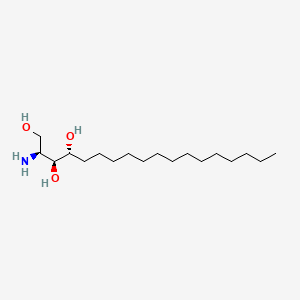phytosphingosine
phytosphingosine is a lipid of Sphingolipids (SP) class. Phytosphingosine is associated with abnormalities such as Infection, Nodule, Dehydration, Neuropathy and nervous system disorder. The involved functions are known as Saturated, sphingomyelin synthase activity, Heat-Shock Response, Cell Growth and Apoptosis. Phytosphingosine often locates in Clone, Protoplasm, Mitochondria, soluble and Cytoplasmic matrix. The associated genes with phytosphingosine are SGMS1 gene, BCL2 gene, Chromatin, Homologous Gene and DLEU2 gene. The related lipids are Sphingolipids, inositolphosphorylceramide, Phosphatidylserines, dihydroceramide and Fatty Acids. The related experimental models are Knock-out.
References related to functions published in J. Biol. Chem.
| PMID | Journal | Published Date | Author | Title |
|---|---|---|---|---|
| 9446592 | J. Biol. Chem. | 1998 | Skrzypek MS et al. | Inhibition of amino acid transport by sphingoid long chain bases in Saccharomyces cerevisiae. |
| 9195906 | J. Biol. Chem. | 1997 | Qie L et al. | Identification of a Saccharomyces gene, LCB3, necessary for incorporation of exogenous long chain bases into sphingolipids. |
| 9092515 | J. Biol. Chem. | 1997 | Nagiec MM et al. | Sphingolipid synthesis as a target for antifungal drugs. Complementation of the inositol phosphorylceramide synthase defect in a mutant strain of Saccharomyces cerevisiae by the AUR1 gene. |
| 11468289 | J. Biol. Chem. | 2001 | Chung N et al. | Phytosphingosine as a specific inhibitor of growth and nutrient import in Saccharomyces cerevisiae. |
| 11337502 | J. Biol. Chem. | 2001 | Abe M et al. | Yeast 1,3-beta-glucan synthase activity is inhibited by phytosphingosine localized to the endoplasmic reticulum. |
| 10764732 | J. Biol. Chem. | 2000 | Chung N et al. | Sphingolipids signal heat stress-induced ubiquitin-dependent proteolysis. |
| 15190065 | J. Biol. Chem. | 2004 | Welsch CA et al. | Genetic, biochemical, and transcriptional responses of Saccharomyces cerevisiae to the novel immunomodulator FTY720 largely mimic those of the natural sphingolipid phytosphingosine. |
| 15155728 | J. Biol. Chem. | 2004 | Aoki K et al. | Newly discovered neutral glycosphingolipids in aureobasidin A-resistant zygomycetes: Identification of a novel family of Gala-series glycolipids with core Gal alpha 1-6Gal beta 1-6Gal beta sequences. |
| 15840588 | J. Biol. Chem. | 2005 | Liu K et al. | The sphingoid long chain base phytosphingosine activates AGC-type protein kinases in Saccharomyces cerevisiae including Ypk1, Ypk2, and Sch9. |
| 16407254 | J. Biol. Chem. | 2006 | Panwar SL and Moye-Rowley WS | Long chain base tolerance in Saccharomyces cerevisiae is induced by retrograde signals from the mitochondria. |
| 14522966 | J. Biol. Chem. | 2003 | Park MT et al. | Suppression of extracellular signal-related kinase and activation of p38 MAPK are two critical events leading to caspase-8- and mitochondria-mediated cell death in phytosphingosine-treated human cancer cells. |
| 16141212 | J. Biol. Chem. | 2005 | Sano T et al. | Regulation of the sphingoid long-chain base kinase Lcb4p by ergosterol and heme: studies in phytosphingosine-resistant mutants. |
| 18474589 | J. Biol. Chem. | 2008 | Castro A et al. | Increased resistance of complex I mutants to phytosphingosine-induced programmed cell death. |
| 22277656 | J. Biol. Chem. | 2012 | Montefusco DJ et al. | Sphingoid bases and the serine catabolic enzyme CHA1 define a novel feedforward/feedback mechanism in the response to serine availability. |
| 11056159 | J. Biol. Chem. | 2001 | Jenkins GM and Hannun YA | Role for de novo sphingoid base biosynthesis in the heat-induced transient cell cycle arrest of Saccharomyces cerevisiae. |
| 22275366 | J. Biol. Chem. | 2012 | Guo L et al. | Connections between sphingosine kinase and phospholipase D in the abscisic acid signaling pathway in Arabidopsis. |
| 21454514 | J. Biol. Chem. | 2011 | Bozna BL et al. | Binding strength and dynamics of invariant natural killer cell T cell receptor/CD1d-glycosphingolipid interaction on living cells by single molecule force spectroscopy. |
| 21330371 | J. Biol. Chem. | 2011 | Guo L et al. | Phosphatidic acid binds and stimulates Arabidopsis sphingosine kinases. |
| 16129666 | J. Biol. Chem. | 2005 | Mare L et al. | APP1 transcription is regulated by inositol-phosphorylceramide synthase 1-diacylglycerol pathway and is controlled by ATF2 transcription factor in Cryptococcus neoformans. |
